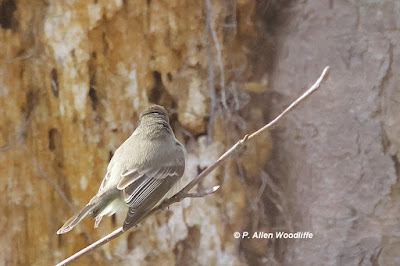In spite of the cool down of late, reflecting more normal weather conditions, birds continue to trickle in. Of course some may never have left, but more of their kind seem to be showing. For example, Northern Flickers were hard to come by over the winter, but now it is not unusual to see a dozen or more in a single outing.
Likewise are the Golden-crowned Kinglets.
Chipping Sparrows are definitely new for the season on the bird front....
....as are Eastern Phoebes. They are notably hardy considering they are a flycatcher, but can survive in the cold by feeding on spiders and such, tucked under the eaves of buildings if necessary, at least for awhile.
They are quite active, on the hunt for small flying insects and don't often give the best view, but you take what you can get!On the water bird front, the diversity of ducks continues, with more and more of each species to see. Many will be leaving for their nesting grounds soon, if some haven't already, but there are still lots around.
 |
| Canvasback |
 |
| Common Merganser pair |
 |
| Northern Shoveler |
Turkey Vultures are increasing in numbers, most often seen in flight.
Horned Larks are frequently seen along the roadsides and field edges. Some are paired up, and likely are in the early stages of nesting in the un-tilled fields.
Regular bird residents sometimes give a good photo op, which I may take advantage of.
As mentioned in previous posts, the nesting season for some is already well underway. This next photo is of a nest that can be seen, with some difficulty, along the west South Point Trail at Rondeau. At first I wasn't sure if it was an occupied nest or not, but after taking this photo with a good zoom, and greatly cropping it, I noticed the white tail feathers sticking out towards me. They are a little difficult to see against the bland sky background. It isn't as nearly as visible as the subsequent photo, taken several years ago along the Marsh Trail.
This nest came tumbling down a couple of years afterwards, due to some high winds that took the whole tree down.
And the Black-billed Magpies continue along Fargo Road. Some observers have photographed them with nesting material in their beak, heading for the nest tree.
If you would like to subscribe, or unsubscribe, to Nature Nuggets, send and email to: prairietramper@gmail.com



















Lovely to see summer birds returning. Such lovely colours in the Black-billed Magpie and Northern Flicker, not birds that I'm familiar with. Thank you for the care and time you take with what you do.
ReplyDeleteThanks for your comment, Paula. It is indeed wonderful to see the assortment of avian creatures returning in their breeding plumage, and even to see the ones that are here year round as their plumage changes to show off their beauty.
Delete